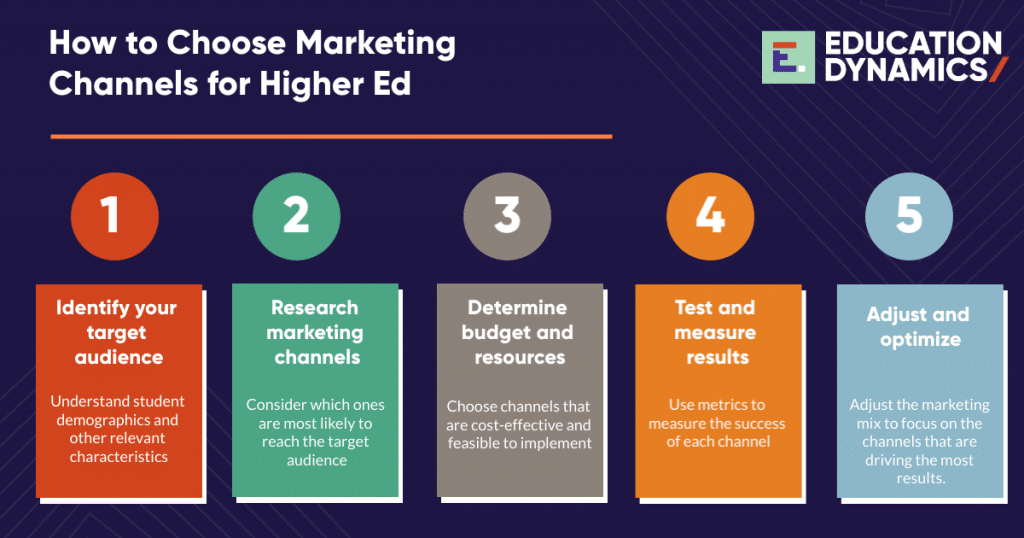Find the Right Higher Ed Marketing Media Mix

Author’s Note: This post was originally published in February 2023 and has been updated for accuracy and comprehensiveness.
Molded Jello recipes make up a surprising percentage of any American recipe book from the 1950s. A hostess of the era could have fed guests four courses of wobbly, gelatin-encased food and had people asking for seconds. Yet, tastes have changed, and so has the diversity of modern dinner party menus. The same is true for the higher education marketing media mix.
A one-channel approach certainly won’t deliver optimal enrollment results. Colleges and universities need to balance and re-balance their media mix based on down-funnel performance to get optimal results for their school and their audiences. Fortunately, modern higher ed marketers have access to data that can help them continuously optimize their mix for enrollment growth in 2023 and beyond.
How to Choose Marketing Channels for Higher Ed
Step 1: Identify the Potential Students that Best Fit Your Programs
Identifying the appropriate student audience isn’t merely a strategic move; it’s the key to unlocking effective communication and engagement. This knowledge is foundational for higher education marketers in developing efficient, respectful marketing strategies that align with the expectations of prospective students.
Understanding the characteristics, needs, and preferences of these students empowers colleges and universities to craft relevant marketing messages and campaigns, as well as customize content, offers, and interactions. This personalized approach allows marketers to address students’ pain points, aspirations, and motivations directly, making it easier for them to understand the benefits of enrolling in a particular program or institution.
Step 2: Research marketing channels that Resonate with Your Audience
One of the primary reasons is to identify which marketing channels are most likely to reach their target audience effectively. Understanding where prospective students spend their time and engage with content online allows higher education marketers to allocate their resources wisely and focus their efforts on platforms that resonate with their audience. It guides decisions on content creation and the overall marketing strategy, ensuring that resources are used efficiently to engage and attract prospective students.
Determine which social media platforms are most popular among their prospective students and tailor your content and messaging accordingly. Effective social media marketing can foster engagement, facilitate two-way communication, and build a sense of community among current and potential students.
Choosing the most suitable marketing channel also guides content marketing tactics. By identifying the types of content that perform well on specific platforms, higher education marketers can tailor their content to match the preferences and behaviors of their target audience. This ensures that the content is not only seen but also engages and resonates with prospective students.
Step 3: Determine Budget and Resources to Inform Strategic Decisions
Assessing the budget and available resources helps marketers make efficient and effective decisions. It ensures that financial and human resources are allocated to channels and strategies that have the highest potential for reaching and engaging the target audience. It ensures that marketing strategies align with institutional goals, are cost-effective, and provide the best chance of success in reaching and engaging the target audience while managing financial constraints effectively.
Step 4: Test and Measure Results Gauge the Impact of Marketing Efforts
Testing and measuring results play a pivotal role in selecting the right marketing mix for higher education institutions. These practices offer data-driven insights, ensuring that marketing strategies are grounded in evidence rather than assumptions. They help identify the most effective channels, optimize resource allocation, and demonstrate the value of marketing efforts to institutional stakeholders.
Testing and measurement help institutions adjust and improve their strategies continuously, spotting weak spots early on.
Step 5: Adjust and Optimize Align with Institutional Goals
Adjusting and optimizing the marketing mix is a critical practice for higher education marketers. It means focusing resources on channels that deliver the best results, ensuring efficient budget allocation and maximum impact. This process also fosters flexibility, allowing institutions to adapt swiftly to changing market conditions and emerging trends.
Moreover, data-driven decision-making is at the core of this practice. Marketers rely on performance metrics to refine strategies and allocate resources effectively. By being agile and proactive, institutions can gain a competitive edge and maintain relevance in the dynamic higher education landscape, ultimately achieving their goals more efficiently.

4 Media Types To Include In The Media Marketing Mix
An effective marketing mix is diversified and carefully balanced. Diverse platforms and formats help marketing messages reach the right students in a targeted, cost-effective way. While the optimum mix may differ depending on the college, ideal audience, and credential type, there are several marketing channels that can be effective for higher education marketing.
1. Digital marketing – search, social, email and online ads
Education advertisers continue to increase spend on digital marketing. Search spending went up by around 175% in 2022 and online video spending grew 128%.
Google remains the largest media channel by ad adoption. But, it’s no longer the only giant in the space. Apple search ads is equally large. CPC varies widely depending on the program category being advertised.
On social media, Facebook usage has been dropping since 2014, but Instagram and Snapchat saw a rise in users over the same period. Today, two-thirds of U.S. teens use TikTok. Whether categorized as a search engine or a social media platform, the fact remains that Youtube is watched by 95% of U.S. teens, a massive potential market.
All of these mediums have a wide reach, while allowing marketers to tailor their audience targeting and ad messaging. Digital marketing is likely to make up a big portion of any higher education media marketing mix.
2. Awareness marketing – TV, streaming, radio, and out of home
While digital is often a major focus for marketers, other types of platforms offer more opportunities for awareness marketing. More than 85 million U.S. households stream content via CTV every month. Those households streamed an average of 122 hours of CTV content per month. Netflix’s recent move to offer an ad-supported option may have expanded the streaming opportunities since the platform accounts for both the largest reach and the highest number of hours.
Platforms like Spotify, Hulu and the ubiquitous YouTube, each have slightly different audiences. Placements on these various platforms can increase the overall branding and brand equity.
3. Events – open houses, information sessions, webinars
In-person and online events often get left out of conversations about marketing mix, but they can make an impact. In-person events like open houses, hybrid-style information sessions, and online webinars all create opportunities to engage potential students and answer their questions about the college or university.
4. Partnerships – businesses, nonprofits, professional associations
Partnering with other organizations or businesses can be a great way to reach new audiences and offer value to potential students. Such partnerships can create a two-way exchange. Not only can they help colleges and universities connect to potential students, partnerships can also help institutions gather information about the credentials and outcomes students are looking for.
Each of these channels is most effective when targeted based on audience and goals. Of course, budget is a factor as well. By monitoring down-funnel performance, specifically enrollments and graduates, marketers can make informed decisions about how to balance their marketing mix and their budget.
Balancing a marketing media mix is a lot more challenging than planning a dinner menu. Many college and university teams turn to EducationDynamics, a full-service marketing agency that can help them build comprehensive strategies and manage placements. We help our college and university clients talk to prospective students where they live and track results from consideration to graduation and beyond. No gelatin mix required.